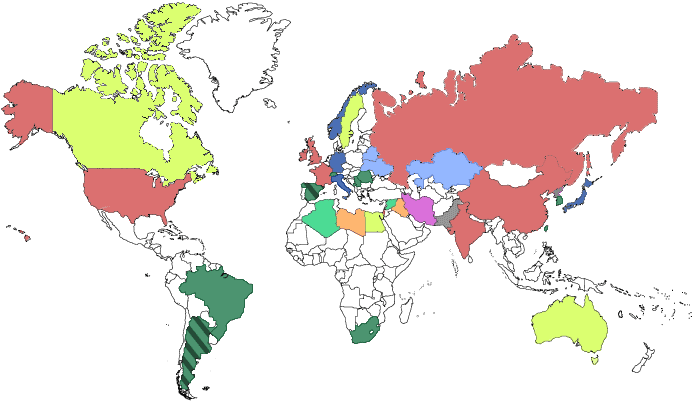Nuclear Weapons Programs Worldwide: An Historical Overview
We are often asked which countries have nuclear weapons, are seeking them, or may seek them in the future. In trying to answer the question, we have had to consider which countries possessed or tried to obtain nuclear weapons in the past. Our findings about both current and historical nuclear weapons programs are outlined on an interactive world map, and summarized in a companion table.

In total, about 30 countries have sought nuclear weapons, and ten are known to have succeeded. Of these ten, South Africa remains the only one that subsequently dismantled that program. The countries with successful, on-going nuclear weapons programs are Britain, France, China, India, Israel, North Korea, Pakistan, Russia, and the United States.
In addition, Iran is suspected of actively seeking nuclear weapons. Libya, previously suspected of pursuing a nuclear weapons program, acknowledged and began dismantling that program in December 2003. Iraq’s nuclear weapons program is now ended. The security situation facing South Korea and Taiwan continues to raise concerns that they may decide to seek nuclear weapons in the future. Algeria sometimes raises concern because of domestic unrest and the nature of its civil nuclear facilities.
Suspcions also exist that Syria had intentions to produce nuclear weapons, but no nuclear weapons program had been identified. In September 6, 2007 Israeli jets bombed an installation in Al Kibar, Syria. The site was quickly covered by new construction but analysis suggested that the destroyed building may have been a Yongbyon style nuclear reactor.
The information presented here about past and current nuclear weapons programs is organized by historical era, where the entry into force of the Nuclear Non-Proliferation Treaty (NPT) in 1970 is a watershed. Before this date, many European and developed countries considered acquiring nuclear weapons. Some took concrete steps to acquire the wherewithal to build them. After 1970, few did so. In addition, of the nine states that successfully built nuclear weapons, all but Pakistan started before 1970.
The exact number of countries that sought nuclear weapons is difficult to determine. Traditionally, much secrecy has surrounded nuclear weapons programs, particularly in their early stages. This secrecy often continues long after a particular program has ended.
For countries that have nuclear weapons, we have provided estimated inventories of military and excess stocks of separated plutonium and highly enriched uranium. These estimates are derived from ISIS’s data. For the former and current de facto nuclear weapon states (Israel, India, Pakistan, North Korea, and South Africa) we have provided an estimate for the number of nuclear weapons in each country’s stockpile, based on their inventories of fissile material. For more information on these inventories, see Global Fissile Material Inventories, June 2004.
The information we present here is highly summarized. There are many authoritative studies of specific nuclear weapons programs, a few of which we have cited, and which we encourage the reader to consult. However, this reference list is by no means exhaustive, and we plan to add additional references as this effort is periodically revised and updated.
We welcome feedback and comments on this effort.
* ISIS acknowledges the work of Travis Nels, who interned at ISIS in the summer of 2000 and designed the web site presentation of the material on the following pages. This information was updated in October 2004 by Kimberly Kramer and Paul Brannan.
Please note:
- No evidence exists of an Argentine nuclear weapons program, but suspicions remain that one existed.
- Spain, which had a military dictatorship, developed unsafeguarded nuclear facilities during the 1960s and 1970s. U.S. officials said in the late 1980s that they suspected that Spain had nuclear weapons ambitions or a program.
- Nigeria and Indonesia are occasionally named as countries that had nuclear weapons intentions, but these claims have not been substantiated and thus are not included here.
‹ Back
